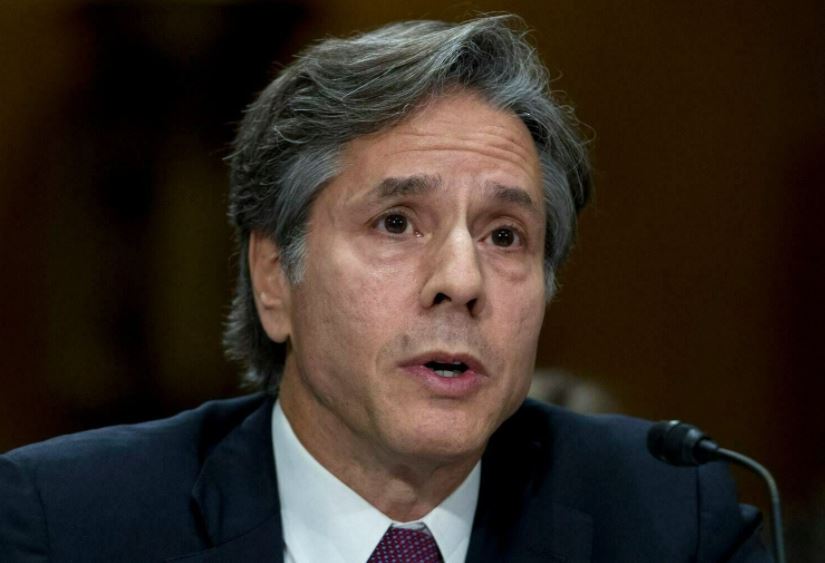
A few days ago the ridiculous Jew Antony Blinken was in Niger demanding the niggers there that they normalize relations with Israel.
Why would the nigger people from Niger do this?
What do they gain from a relationship with these Jews? Was Blinken threatening to dump gay trannies into their country if they didn’t?
This demand is a joke. It is no wonder why Africans are doing business with Russia and China. Neither of these countries are forcing them to like Jews, queers and trannies.—Comment: This is exactly what he and his Cabal (Crime Syndicate are worried about…the Middle East and Africa Pivoting to Russia & China who have been Nice Guys Giving them respect and good deals unlike the Racist Hate Filled Geopolitics of the U.S. & U.K. only representing the crime syndicate-the Synagogue of Satan. Guess the crime cabal’s threats, poisoning people and murdering leaders no longer works lol. GOOD!

Comment: Africans are looking forward to a wonderful future of prosperity and dignity.. See below:
On the (New Silk) Road
Factories are the bridge connecting China to Africa — but is China in it for the long run?
By Sarwar A. Kashmeri June 21, 2018
EMERGING GLOBAL ORDER
Irene Yuan Sun, Harvard Business Review Press. 211 pp. 2017.
China’s One Belt One Road Initiative (BRI), or the New Silk Road as it is popularly known, is a massive, multiyear project that will connect China to more than 60 countries in Asia, the Middle East, and Europe. China expects to spend over a trillion dollars on building ports, high-speed railway links, and infrastructure in these countries to create a web of trade connections. Besides the commercial benefits, the soft-power implications of the BRI could place China at the center of influence in scores of countries, many of which are United States allies.
Just as the West is waking up to the impact of the BRI, this engaging and highly readable book by Irene Yuan Sun has come along to illuminate how Chinese investment and leadership have been reshaping Africa and winning the continent’s hearts and minds for decades.
This is a big deal. Africa’s land area is larger than that of China, the United States, India, and all of Europe, combined. According to the U.S. Chamber of Commerce, by 2025, Africa’s household-consumption will total $2.1 trillion. By 2050, the continent will be home to over 2.5 billion people. Africa is poised to become the largest business opportunity since China embraced capitalism.
Add the commercial and soft-power benefits of China’s African investments to those that will accrue to it from the BRI, and one begins to understand that China’s grand strategy aims at replacing the United States as the world’s dominant commercial player and influencer.
What is particularly intriguing in Sun’s book is the revelation that the strategy being used by Chinese investors in Africa is the same one that China used to transform itself into the world’s powerhouse economy. Disregarding Washington-led financial and development organizations, such as the World Bank and the International Monetary Fund, which hold that developing countries should focus on limited government and privatization, China chose the policy of government-fueled industrialization executed by entrepreneurs to convert itself into the factory of the world. The results of that contrarian decision speak for themselves.
In the 1980s, when China began to rebuild its broken economy following the Cultural Revolution and Great Leap Forward, it had one-fifth of the world’s population but only three percent of global manufacturing output. It was poorer on a per capita basis than many African countries. But rebuild it did. China’s gross domestic product grew nearly 10% a year for three decades, lifting 750 million people out of poverty — the largest and fastest growth in recorded history. The country now accounts for over a quarter of the world’s manufacturing output, and within the next decade will overtake the United States as the largest economy in the world.
As Sun writes, “Despite the current hype about the rise of robotics and the possibility of fully automating production, the current factory model, in which real people make tangible goods, is far from dead.” And, the author continues, as the history of countries around the world demonstrates: “if you want to get rich, build yourself a manufacturing industry.” [emphasis the reviewer’s]
“Factories are the bridge that connects China, the current Factory of the World, to Africa, the next Factory of the World,” Sun tells us. “Industrialization is how China reshaped itself from a poor, backward country into one of the largest economies in the world in less than three decades. By becoming the next Factory of the World, Africa can do the same.” This book provides ample evidence that Africa is well on its way toward reaching that goal.
Manufacturing is not just a bridge that connects China to Africa; it is a 16-lane super highway moving Chinese manufacturing expertise, entrepreneurs, and factories to the continent. To explain this phenomenon, Sun uses the “flying geese theory,” business school jargon for the rapid industrialization of East Asian countries in the 20th century. The theory postulates that manufacturing firms act like flying geese, migrating from country to country and from product to product as costs and demand change and factories become uncompetitive.
For example, Japan became the first East Asian country to bootstrap itself into one of the world’s leading economies by industrializing. Its rise in living standards was then the fastest ever seen. But rising costs of production forced Japanese firms to relocate abroad, in Hong Kong, Singapore, South Korea, and Taiwan — a move that triggered a new wave of rapid economic development in those four countries. Formerly rickety economies were transformed, and the Four Asian Tigers — rich, industrialized — were born.
“A wave of Japanese entrepreneurs spawned a wave of Taiwanese entrepreneurs who spawned a wave of Chinese ones,” Sun explains. “The fact that these Chinese entrepreneurs are now running factories in Africa gives rise to the possibility that the next wave may very well be African.” Her book provides impeccably researched evidence that this wave has been well underway for decades, under Chinese stewardship.
In 2000 Chinese companies made a mere two investments in Africa. Jump ahead to today. A recent research project, co-headed by the author for the global consulting firm McKinsey & Company, showed that there are already more than 10,000 Chinese firms in Africa. In Nigeria — where the population will be greater than that of the United States by 2050 — Chinese carmakers, construction materials producers, and consumer goods manufacturers are busy competing for its vast business market. “In Lesotho, Chinese garment factories make yoga pants for Kohl’s, jeans for Levi’s, and athletic wear for Reebok. Almost all of Lesotho’s production is trucked out and packed onto container ships bound for American consumers,” Sun reports.
Even more important is the level of private sector Chinese manufacturing investment in Africa. The author surveyed nearly 200 manufacturing firms with average annual revenues of $21 million and found that most of them were privately owned. In a telling conversation, Yang Wenyi, a Chinese investor in multiple manufacturing plants in Nigeria, told her, “I have no use for the government. I’m not doing anything illegal, and I’m not looking for government contracts.” This level of foreign manufacturing investment in Africa is unique, according to Sun. She compares it to the $14 billion of U.S. private sector investment in Africa announced by the Obama administration in August 2014, which focused mainly on banking, construction, and information technology. The explanation for this focus is straightforward: “after decades of relocating their factories to developing countries, the United States and other developed nations have very little manufacturing left to offshore…. Only China has enough of a manufacturing sector left to offshore, and much of that appears to be moving to Africa.”
But what about the oft-heard criticism that Chinese firms do not hire Africans? Sun’s study of more than 1,000 Chinese firms employing more than 300,000 people showed the opposite: more than 95 percent of the employees in manufacturing were Africans. Another fact worth noting is that most Chinese factory owners in Africa work for themselves, not for the Chinese government.
Born in China, Sun is a graduate of Harvard Business School, Harvard Kennedy School, and Harvard College. She co-leads McKinsey & Company’s work on Chinese engagement in Africa, where she has lived. Her personal anecdotes are a highlight of this book. For instance, she recalls for the reader her excitement as a little girl when her father brought back a box of plastic wrap to the family home from Japan. “I wasn’t allowed to touch the precious, glimmering film brought from afar,” she writes.
Sun has chosen four widely diverse African countries to illuminate the book’s argument:
NIGERIA: Behemoth … largest population and largest economy on the continent
LESOTHO: Landlocked within South Africa … population just two million, scarce resources
KENYA: Flagship economy of East Africa … GDP growth of 5–6 percent … labeled the Silicon Savannah
ETHIOPIA: Transitioning to a market economy from a brutal Marxist dictatorship … strict capital controls and state monopolies
The book is divided into two parts: the first describes what it looks and feels like to be inside Chinese factories in Africa; the second covers the possibilities — economic, political, and social — that these factories bring to the continent. Both the choice of countries and the book’s structure make this difficult subject accessible for a lay reader.
The characters that populate the narrative are each worth a book unto themselves. We are introduced to Mr. Sun (no relation to the author), a native of Wenzhou, China, birthplace of ceramics, who discovered ceramics as his worldly calling and built a $40 million ceramics factory in Nigeria. The Lee family, who own the market in Nigeria for flipflops, were paid the ultimate compliment when Walmart came calling to do business. The Lees turned them down! Other equally remarkable Chinese entrepreneurs include Lawrence Tung, an American of Chinese ancestry and a Wharton grad, whose family came to Africa 50 years ago. He recently gave up his American citizenship for Nigerian, explaining, “We’re here for the long run. This is our second home.”
Sun is most persuasive as she conveys the sense of the personal for Chinese investors, managers, and workers in Africa who have seen China change in their lifetimes. They grew up and lived in the kind of poverty they see in Africa today, and they think there is no reason Africa will not become as rich as China, and soon. “There are no pilot projects, no NGOs, no theorizing about paths to development — only the blunt attempt to re-create what China built for itself over the past three decades,” Sun writes.
This book graphically illuminates how China continues to outflank the United States in the world’s potentially biggest business market. “Chinese factories in Africa: This is the future that will create broad-based prosperity for Africans and usher in the next phase of global growth for a large swath of the Chinese economy,” the author concludes.
The industrial transformation of Africa by China is a sobering prospect if you are an American. Unless you agree with former Vice President Biden, that “Nobody has ever made money betting against America!”










